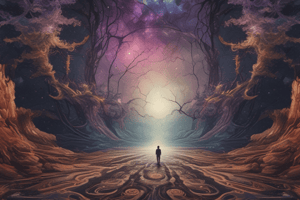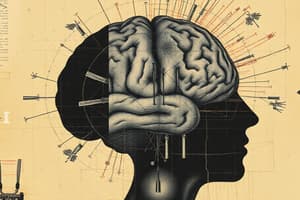Podcast
Questions and Answers
What is the role of the suprachiasmatic nucleus in sleep regulation?
What is the role of the suprachiasmatic nucleus in sleep regulation?
- Controls rapid eye movement during sleep
- Initiates the sleep cycle
- Regulates hormonal changes in response to light (correct)
- Maintains circadian rhythms through temperature regulation
Circadian rhythms influence only body temperature and not alertness.
Circadian rhythms influence only body temperature and not alertness.
False (B)
What percentage of life do individuals spend sleeping?
What percentage of life do individuals spend sleeping?
25%-33%
The type of sleep characterized by relaxation and some awareness of the environment is called ______.
The type of sleep characterized by relaxation and some awareness of the environment is called ______.
Match the stages of NREM sleep with their descriptions:
Match the stages of NREM sleep with their descriptions:
Which of the following is a consequence of sleep deprivation?
Which of the following is a consequence of sleep deprivation?
All individuals experience altered states of consciousness in the same way.
All individuals experience altered states of consciousness in the same way.
What happens to melatonin production when exposed to bright light?
What happens to melatonin production when exposed to bright light?
Which sleep stage is characterized by eye movements and increased heart rate?
Which sleep stage is characterized by eye movements and increased heart rate?
Dreams are generally well understood and can consistently be interpreted.
Dreams are generally well understood and can consistently be interpreted.
What theory suggests that dreams are symbolic representations of our desires and fears?
What theory suggests that dreams are symbolic representations of our desires and fears?
_________ is a common altered state of consciousness characterized by sleepy attentiveness.
_________ is a common altered state of consciousness characterized by sleepy attentiveness.
Match the following dream theories with their descriptions:
Match the following dream theories with their descriptions:
What do cultural variations in dreams often reflect?
What do cultural variations in dreams often reflect?
Meditation and hypnosis are similar in that both involve a state of relaxed focus.
Meditation and hypnosis are similar in that both involve a state of relaxed focus.
In research by Ghandi and Oakley, what was the independent variable?
In research by Ghandi and Oakley, what was the independent variable?
Flashcards are hidden until you start studying
Study Notes
Consciousness
- Consciousness is the perception of one’s own mental life at different levels of awareness
- It’s a psychological representation of something that happened in the past which appears continuous and perfect, but it also delayed and subject to error
- The “BIG Problem" of Psychology is deciding where neural activity becomes conscious experience
- Neural activity is a brain’s response to a stimulus
- The psychological interpretation of that neural activity is perception
- There are three key features of consciousness:
- Qualitativeness - feeling of what it is like to be you
- Subjectively - Everyone has their own experience that cannot be experienced by anyone else
- Unity - Single and unified experience
Altered States of Consciousness
- Susan Blackmore earned a PhD in Parapsychology and is a significant contributor to the understanding of consciousness
- She stated “We don’t think of consciousness because it doesn't feel like anything special”
- Blackmore uses the idea of altered states of consciousness to understand normal consciousness
- Perceptual time dilation occurs when our perception of the time is stretched out during extreme stress or excitement.
- Time appears to slow down because cognition speeds up
Sleep & Dreams
- We spend 25% - 33% of our lives sleeping
- College students average about 7 hours of sleep a night
- Sleep deprivation leads to poor concentration, reduced self-control, exhaustion, fatigue, lethargy, and eventually hallucinations after long periods of sleep deprivation
- Sleep regulation is controlled by circadian rhythms
- Circadian rhythms regulate several activities in the body including body temperature, alertness, bowel movements, and hormone levels
- The suprachiasmatic nucleus and the pineal gland are responsible for the circadian pacemaker:
- Low light triggers the pineal gland to produce melatonin which makes us sleepy
- Bright light stops the production of melatonin promoting wakefulness
- Sleep homeostasis is the balance of sleep and wakefulness
- There are two types of sleep:
- NREM (Non-Rapid Eye Movement): This type of sleep has 4 stages:
- Stage 1: relaxed wakefulness with some awareness of the environment
- Stage 2: Light sleep with no awareness of the environment, yet perceptual responsiveness
- Stage 3: “Slow wave” sleep where it is difficult to awaken
- Stage 4: Deepest sleep, where awakening is difficult and results in disorientation and shock
- REM (Rapid Eye Movement):
- Characterized by increased heart rate, blood pressure, and respiration, muscle spasms, and rapid eye movement
- NREM (Non-Rapid Eye Movement): This type of sleep has 4 stages:
- Dreams are a poorly understood phenomenon and typically make logical sense
- There are two types of dreams
- Apex Dreaming: Fantastical events
- Ordinary Dreaming: Regular or mundane events
- Areas of the brain associated with disbelief are not part of the activations in dreams
- We also lack the capacity to create new memories during dreams, except when just about to wake up
Theories of Dreaming
- There are three primary theories for dreams
- Wish-fulfillment: Sigmund Freud theorized that dreams are symbolic representations of desires, beliefs, and fears. He called dreams the “royal road to the unconscious.”
- Cognitive: Dreaming appears random; however, it’s your mind consolidating memories and producing better memory
- Physiological Function: Brains are randomly stimulated during sleep in order to keep them healthy and to remove naturally occurring plaque
- Dreams reflect the worlds in which we live and vary by age and culture
- Young people generally experience themes of aggression, fear, social acceptance, social navigation, studying, grades, and sexual themes in their dreams
- Cultural variations in dreams often include animals in rural societies and same-sex characters in gender-segregated societies
- Idle thoughts or daydreams are often about the same themes as dreams
Hypnosis / Meditation
- Hypnosis is a common alert state of consciousness that can happen between stages 1 and 2 of sleep.
- It can be induced by a trained individual or by accident
- Hypnosis makes us more susceptible to suggestion as we are focused and attentive in a single way
- The effectiveness of hypnosis depends largely on the participant’s belief in the procedure.
- Gandhi and Oakley’s study in 2005 found that hypnosis is more effective when people believe they are being hypnotized
- Meditation is a self-induced state that is similar to hypnosis, between stages 1 and 2 of sleep.
- It involves a relaxed focus where we are aware of the present and all else is irrelevant
- Thoughts can either by suppressed or allowed during meditation
- There are two types of meditation:
- Mindfulness: Thoughts are allowed
- Mantra: Thoughts are suppressed
- Meditation allows calm and not thinking as we place attention on a specific thing during controlled breathing
- Long-term meditation leads to altered brain functioning and unusual neurological activity, almost like sleeping on demand, which is shown through brain imaging studies
- Meditation thickens the cortical region of the brain that is associated with attention and emotion regulation
- Correlation evidence suggests that meditation may have these effects, or that other factors, such as lifestyle changes, may be responsible for the brain changes.
Studying That Suits You
Use AI to generate personalized quizzes and flashcards to suit your learning preferences.




